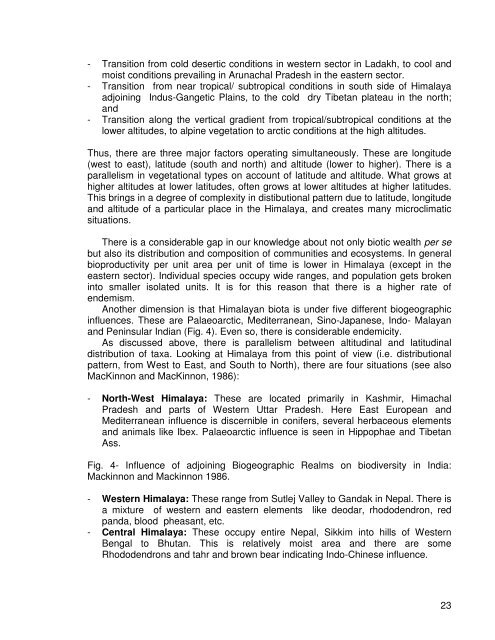Pandit Govind Ballabh Pant Memorial Lecture: II
Pandit Govind Ballabh Pant Memorial Lecture: II
Pandit Govind Ballabh Pant Memorial Lecture: II
You also want an ePaper? Increase the reach of your titles
YUMPU automatically turns print PDFs into web optimized ePapers that Google loves.
- Transition from cold desertic conditions in western sector in Ladakh, to cool and<br />
moist conditions prevailing in Arunachal Pradesh in the eastern sector.<br />
- Transition from near tropical/ subtropical conditions in south side of Himalaya<br />
adjoining Indus-Gangetic Plains, to the cold dry Tibetan plateau in the north;<br />
and<br />
- Transition along the vertical gradient from tropical/subtropical conditions at the<br />
lower altitudes, to alpine vegetation to arctic conditions at the high altitudes.<br />
Thus, there are three major factors operating simultaneously. These are longitude<br />
(west to east), latitude (south and north) and altitude (lower to higher). There is a<br />
parallelism in vegetational types on account of latitude and altitude. What grows at<br />
higher altitudes at lower latitudes, often grows at lower altitudes at higher latitudes.<br />
This brings in a degree of complexity in distibutional pattern due to latitude, longitude<br />
and altitude of a particular place in the Himalaya, and creates many microclimatic<br />
situations.<br />
There is a considerable gap in our knowledge about not only biotic wealth per se<br />
but also its distribution and composition of communities and ecosystems. In general<br />
bioproductivity per unit area per unit of time is lower in Himalaya (except in the<br />
eastern sector). Individual species occupy wide ranges, and population gets broken<br />
into smaller isolated units. It is for this reason that there is a higher rate of<br />
endemism.<br />
Another dimension is that Himalayan biota is under five different biogeographic<br />
influences. These are Palaeoarctic, Mediterranean, Sino-Japanese, Indo- Malayan<br />
and Peninsular Indian (Fig. 4). Even so, there is considerable endemicity.<br />
As discussed above, there is parallelism between altitudinal and latitudinal<br />
distribution of taxa. Looking at Himalaya from this point of view (i.e. distributional<br />
pattern, from West to East, and South to North), there are four situations (see also<br />
MacKinnon and MacKinnon, 1986):<br />
- North-West Himalaya: These are located primarily in Kashmir, Himachal<br />
Pradesh and parts of Western Uttar Pradesh. Here East European and<br />
Mediterranean influence is discernible in conifers, several herbaceous elements<br />
and animals like Ibex. Palaeoarctic influence is seen in Hippophae and Tibetan<br />
Ass.<br />
Fig. 4- Influence of adjoining Biogeographic Realms on biodiversity in India:<br />
Mackinnon and Mackinnon 1986.<br />
- Western Himalaya: These range from Sutlej Valley to Gandak in Nepal. There is<br />
a mixture of western and eastern elements like deodar, rhododendron, red<br />
panda, blood pheasant, etc.<br />
- Central Himalaya: These occupy entire Nepal, Sikkim into hills of Western<br />
Bengal to Bhutan. This is relatively moist area and there are some<br />
Rhododendrons and tahr and brown bear indicating Indo-Chinese influence.<br />
23











